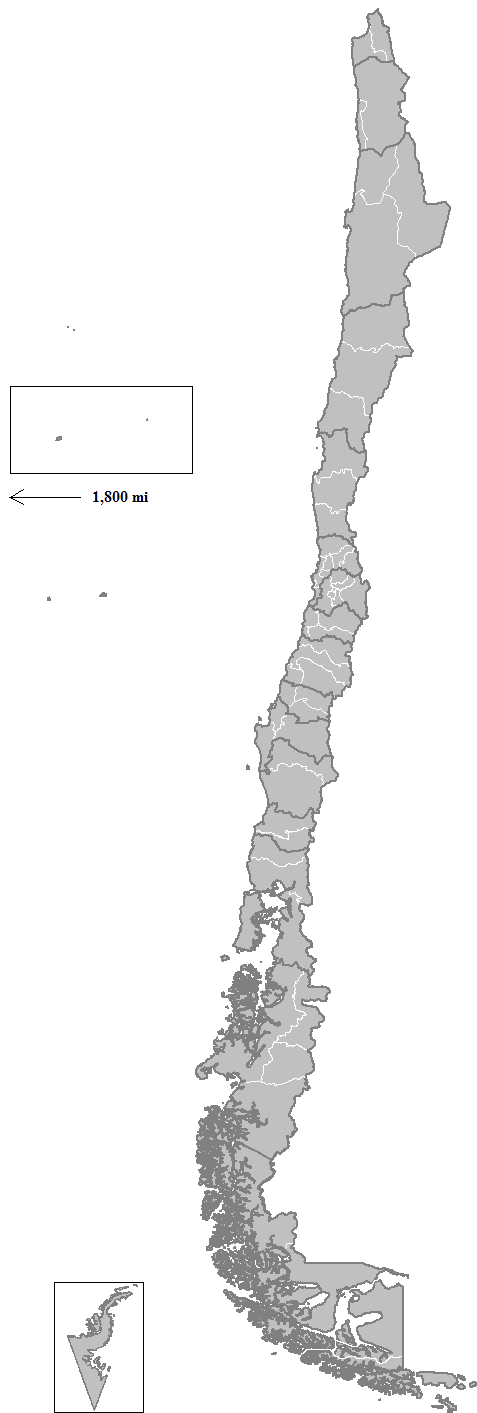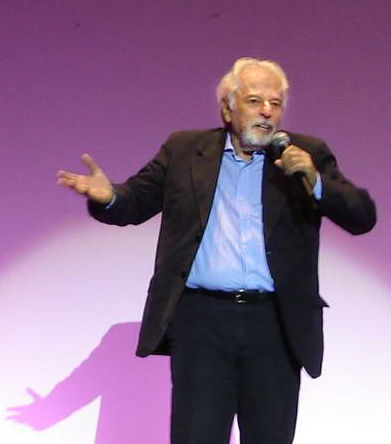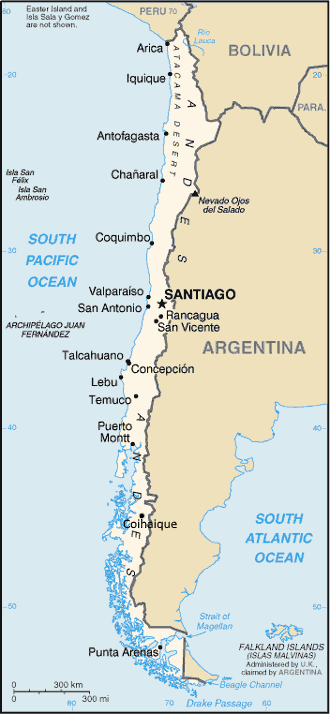|
Tocopilla
Tocopilla is a city and commune in the Antofagasta Region, in the north of Chile. It is the capital of the province that bears the same name. Every year Tocopilla celebrates its anniversary on 29 September with a big show the day before, which includes a parade down in the main street of the city, food and a fireworks display at midnight. The city is divided into two main parts consisting of the central city and smaller portion known as ''La Villa Sur'' (in which the more luxurious houses are located). The two parts are divided by the thermoelectric power plant and a large saltpeter processing and shipping plant, with the coastal highway connecting the two portions. The northern portion of Tocopilla is home of the municipal buildings, the central square and many stores and shops. The steep gradient of the city from beach to vertical hillside is covered in houses and apartments crammed together to save space. A large artificial beach called "Covadonga" and a small artificial ... [...More Info...] [...Related Items...] OR: [Wikipedia] [Google] [Baidu] |
Tocopilla Province
Tocopilla Province ( es, Provincia de Tocopilla) is one of the three provinces in the northern Chilean region of Antofagasta (II). Its capital is the city of Tocopilla. Geography and demography According to the 2012 census by the National Statistics Institute (''INE''), the province spans an area of and had a population of 28,840 inhabitants, giving it a population density of . Between the 1992 and 2002 censuses, the population fell by 18.4% (7,129 persons). Administration As a province, Tocopilla is a second-level administrative division of Chile, which is further divided into two communes (''comunas''). The province is administered by a presidentially appointed provincial delegate. Rossana Montero Morales was appointed by president Gabriel Boric. Communes * Tocopilla Tocopilla is a city and commune in the Antofagasta Region, in the north of Chile. It is the capital of the province that bears the same name. Every year Tocopilla celebrates its anniversary on 29 Septemb ... [...More Info...] [...Related Items...] OR: [Wikipedia] [Google] [Baidu] |
Antofagasta Region
The Antofagasta Region ( es, Región de Antofagasta, ) is one of Chile's sixteen first-order administrative divisions. The second-largest region of Chile in area, it comprises three provinces, Antofagasta, El Loa and Tocopilla. It is bordered to the north by Tarapacá, by Atacama to the south, and to the east by Bolivia and Argentina. The region's capital is the port city of Antofagasta; another one of its important cities is Calama. The region's main economic activity is copper mining in its giant inland porphyry copper systems. Antofagasta's climate is extremely arid, albeit somewhat milder near the coast. Nearly all of the region is devoid of vegetation, except close to the Loa River and at oases such as San Pedro de Atacama. Much of the inland is covered by salt flats, tephra and lava flows, and the coast exhibits prominent cliffs. The region was sparsely populated by indigenous Changos and Atacameños until massive Chilean immigration in conjunction with ... [...More Info...] [...Related Items...] OR: [Wikipedia] [Google] [Baidu] |
2007 Antofagasta Earthquake
The 2007 Tocopilla earthquake occurred on November 14 at . Its epicenter was located between Quillagua and Tocopilla, affecting the Tarapacá and the Antofagasta regions in northern Chile. The earthquake had a moment magnitude of 7.7 and lasted about 3 minutes and 35 seconds. Seventeen aftershocks of magnitude greater than 5.3, including one of magnitude 7.1 and two others of magnitude 6.3 or higher, were recorded. The Pacific Tsunami Warning Center issued a tsunami warning, stating a tsunami had been generated; after one hour, this warning was cancelled. The earthquake was felt from Santiago, 1,245 km south from the epicenter, to La Paz, about 700 km north-northeast.Strong earthquake shakes northern Chile, kills at least two AFP news report Tectonic summ ...
|
Alexis Sánchez
Alexis Alejandro Sánchez Sánchez (; born 19 December 1988), also known mononymously as Alexis, is a Chilean professional footballer who plays as a forward for Ligue 1 club Marseille and the Chile national team. He is often lauded as the greatest Chilean player of all time. Dubbed "''El Niño Maravilla''" (The Wonder Child), Sánchez began his senior club career playing for Cobreloa, and signed with Udinese in 2006, aged 18; he won consecutive league titles while on loan to Colo-Colo and River Plate. Sánchez was the subject of a record association football transfer when he signed for Barcelona in 2011 in a transfer worth €37.5 million, becoming the most expensive Chilean player of all time. There, Sánchez won six trophies, including a La Liga title and a Copa del Rey. He then joined Arsenal in 2014 in a transfer worth £31.7 million (€35 million), and won two FA Cups, the 2015 PFA Fans' Player of the Year, and was voted into the 2015 PFA Team of the Year. ... [...More Info...] [...Related Items...] OR: [Wikipedia] [Google] [Baidu] |
Administrative Division Of Chile
The administrative division or territorial organization of Chile exemplifies characteristics of a unitary state. State administration is functionally and geographically decentralized, as appropriate for each authority in accordance with the law. For the interior government and administration within the State, the territory of the republic has been divided into 16 regions (''regiones''), 56 provinces (''provincias'') and 346 communes (''comunas'') since the 1970s process of reform, made at the request of the National Commission on Administrative Reform (''Comisión Nacional de la Reforma Administrativa'' or CONARA). State agencies exist to promote the strengthening of its regionalization, equitable development and solidarity between regions, provinces and communes within the nation. Since 2005, the creation, abolition and designation of regions, provinces and communes, the altering of their boundaries, and the establishment of the regional and provincial capitals are part of co ... [...More Info...] [...Related Items...] OR: [Wikipedia] [Google] [Baidu] |
List Of Communes In Chile
A commune ( es, comuna, ) is the smallest administrative subdivision in Chile. It may contain cities, towns, villages, hamlets as well as rural areas. In highly populated areas, such as Santiago, Valparaíso and Concepción, a conurbation may be broken into several communes. In sparsely populated areas, conversely, a commune may cover a substantial rural area together with several settled areas which could range from hamlets to towns or cities. The term "commune" is ambiguous in English, but the word is commonly used in translation for "comuna", although with some controversy among translators. A comuna is similar to a "county" in Anglo-American usage and practice, and may be more universally understood as a "municipality". Each commune or municipality is governed by a directly elected body known as a municipal council (''concejo municipal'') consisting of a mayor (''alcalde'') and a group of councillors (''concejales''), for a period of four years. The communal civil ... [...More Info...] [...Related Items...] OR: [Wikipedia] [Google] [Baidu] |
Provinces Of Chile
A province is the second largest administrative division in Chile with 56 in total. The largest administrative division in Chile is that of a region with 16 in total. Each provincial presidential delegation (''delegación presidencial provincial'') is headed by a provincial presidential delegate (''delegado presidencial provincial'') appointed by the President. The governor exercises their powers in accordance with instructions from the regional presidential delegate (''delegado presidencial regional''). The provincial delegate is advised by the Provincial Economic and Social Council (''Consejo Económico y Social Provincial'' or CESPRO). No provincial presidential delegations exist in those provinces where the regional capital is located; its functions were merged with those of the regional presidential delegate. The country's provinces are further divided into 346 communes which are administered by an alcalde and municipal council. Until 1976, a province was the main admin ... [...More Info...] [...Related Items...] OR: [Wikipedia] [Google] [Baidu] |
Alejandro Jodorowsky
Alejandro Jodorowsky Prullansky (; born 17 February 1929) is a Chilean-French avant-garde filmmaker. Best known for his 1970s films '' El Topo'' and '' The Holy Mountain'', Jodorowsky has been "venerated by cult cinema enthusiasts" for his work which "is filled with violently surreal images and a hybrid blend of mysticism and religious provocation". Born to Jewish-Ukrainian parents in Chile, Jodorowsky experienced an unhappy and alienated childhood, and so immersed himself in reading and writing poetry. Dropping out of college, he became involved in theater and in particular mime, working as a clown before founding his own theater troupe, the ''Teatro Mimico'', in 1947. Moving to Paris in the early 1950s, Jodorowsky studied traditional mime under Étienne Decroux, and put his miming skills to use in the silent film '' Les têtes interverties'' (1957), directed with Saul Gilbert and Ruth Michelly. From 1960 onwards he divided his time between Mexico City and Paris, where he c ... [...More Info...] [...Related Items...] OR: [Wikipedia] [Google] [Baidu] |
Communes Of Chile
A commune ( es, comuna, ) is the smallest administrative subdivision in Chile. It may contain cities, towns, villages, hamlets as well as rural areas. In highly populated areas, such as Santiago, Valparaíso and Concepción, a conurbation may be broken into several communes. In sparsely populated areas, conversely, a commune may cover a substantial rural area together with several settled areas which could range from hamlets to towns or cities. The term "commune" is ambiguous in English, but the word is commonly used in translation for "comuna", although with some controversy among translators. A comuna is similar to a "county" in Anglo-American usage and practice, and may be more universally understood as a "municipality". Each commune or municipality is governed by a directly elected body known as a municipal council (''concejo municipal'') consisting of a mayor (''alcalde'') and a group of councillors (''concejales''), for a period of four years. The communal civil ... [...More Info...] [...Related Items...] OR: [Wikipedia] [Google] [Baidu] |
List Of Cities In Chile
This is a list of cities in Chile. A city is defined by Chile's National Statistics Institute (INE) as an "urban entity"An "urban entity" is defined by Chile's National Statistics Institute as a concentrated group of dwellings with over 2,000 inhabitants, or between 1,001 and 2,000 inhabitants if 50% or more of its population is economically active, dedicated to secondary and/or tertiary activities. Exceptionally, populated centers dedicated to tourism and recreation with over 250 concentrated dwellings and that do not meet the population requirement are considered urban. with more than 5,000 inhabitants. This list is based on a June 2005 report by the INE based on the 2002 census which registered 239 cities across the country. Complete list of cities by region Largest urban agglomerations This list includes conurbations, "absorptions" and cities with over 100,000 inhabitants, according to the 2017 census. {, {, class="wikitable sortable" , - !, !!Urban Entity!!Region! ... [...More Info...] [...Related Items...] OR: [Wikipedia] [Google] [Baidu] |
Time In Chile
Time in Chile is divided into three time zones. Most of Continental Chile uses the time offset UTC−04:00 in winter time and UTC−03:00 in summer time, while the Magallanes and Chilean Antarctica region uses the time offset UTC-03:00 the whole year. Additionally, Easter Island uses the time offset UTC−06:00 in winter time and UTC−05:00 in summer time. Until 2015, Continental Chile used the time offset UTC−04:00 and Easter Island used UTC−06:00 for standard time, with daylight saving time roughly between October and March every year. In January 2015, the Chilean government announced that the entire country would keep the time offset used during daylight saving time permanently. However, the annual time change was reinstated in 2016 after feedback from the public about an increase in truancy during the winter months, complaints about older computers and other electronic devices not using the right time zone, and fruit growers reporting a 15% loss in productivity. ... [...More Info...] [...Related Items...] OR: [Wikipedia] [Google] [Baidu] |
Quechuan Languages
Quechua (, ; ), usually called ("people's language") in Quechuan languages, is an indigenous language family spoken by the Quechua peoples, primarily living in the Peruvian Andes. Derived from a common ancestral language, it is the most widely spoken pre-Columbian language family of the Americas, with an estimated 8–10 million speakers as of 2004.Adelaar 2004, pp. 167–168, 255. Approximately 25% (7.7 million) of Peruvians speak a Quechuan language. It is perhaps most widely known for being the main language family of the Inca Empire. The Spanish encouraged its use until the Peruvian struggle for independence of the 1780s. As a result, Quechua variants are still widely spoken today, being the co-official language of many regions and the second most spoken language family in Peru. History Quechua had already expanded across wide ranges of the central Andes long before the expansion of the Inca Empire. The Inca were one among many peoples in present-day Peru who already sp ... [...More Info...] [...Related Items...] OR: [Wikipedia] [Google] [Baidu] |





.png)